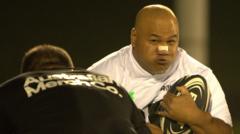The ‘Run It Championship League’ is quickly making a name for itself as the world's newest and fiercest collision sport, originating from the backyards of Australia and New Zealand. In thrilling showdowns, players sprint towards each other, tackling head-on without protective gear. The hype is palpable as videos of these intense moments go viral online.
Founded by a group of friends reminiscing about their teenage games, the league has seen rapid growth, attracting massive audiences, sponsorships, and even prize money reaching A$200,000 for winners. Events have been hosted in major cities, with plans to expand into the UK and US.
However, as excitement builds, so too do concerns over safety. Medical professionals voice their worries about the physical and psychological ramifications of such a dangerous sport. Sadly, incidents have already resulted in tragic outcomes, including the death of a young player emulating the game at a party.
Despite safety protocols, including medical screenings and emergency staff at events, critics argue that chaotic collisions could lead to life-altering injuries. Voices from the Pacific Island community express discontent with the sport's promotion of harmful masculinity that glorifies pain and risk.
As the league readies for its Dubai finale, it remains to be seen if the push for commercial success will overshadow public safety concerns. While some athletes see financial opportunities, experts caution against viewing this chaotic collision as a legitimate sport. Are we witnessing the birth of a breathtaking (yet dangerous) phenomenon, or the commercialization of concussion? Time will tell.
Founded by a group of friends reminiscing about their teenage games, the league has seen rapid growth, attracting massive audiences, sponsorships, and even prize money reaching A$200,000 for winners. Events have been hosted in major cities, with plans to expand into the UK and US.
However, as excitement builds, so too do concerns over safety. Medical professionals voice their worries about the physical and psychological ramifications of such a dangerous sport. Sadly, incidents have already resulted in tragic outcomes, including the death of a young player emulating the game at a party.
Despite safety protocols, including medical screenings and emergency staff at events, critics argue that chaotic collisions could lead to life-altering injuries. Voices from the Pacific Island community express discontent with the sport's promotion of harmful masculinity that glorifies pain and risk.
As the league readies for its Dubai finale, it remains to be seen if the push for commercial success will overshadow public safety concerns. While some athletes see financial opportunities, experts caution against viewing this chaotic collision as a legitimate sport. Are we witnessing the birth of a breathtaking (yet dangerous) phenomenon, or the commercialization of concussion? Time will tell.




















